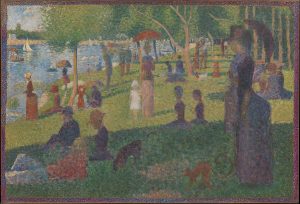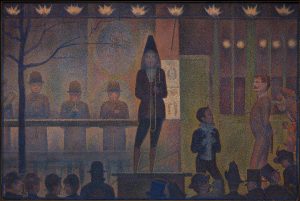Divisionism was part of the Neo-Impressionism art Movement. The divisionist technique consisted in the separation of shapes into individual colored dots creating an amazing optical effect once placed on the canvas.

Neo-Impressionism
Neo-Impressionism was an art movement developed between the last years of 1800 and the early years of 1900. The name was given to those post-impressionist painters that used the divisionist technique. As a matter of fact, the first who empirically employed the divisionism method were the Impressionists like Monet and Pisarro, who discovered they could achieve grander luminosity in their paintings by placing certain complementary colors next to each other. Impressionists implemented this method to recreate light only as a chromatic element. However, the method was not developed systematically and scientifically until the coming of the Neo-Impressionists who wanted to achieve an outstanding lighting sensation using scientific formulas. The most famous divisionist artists were Georges Seurat and Paul Signac.

Divisionism Style
Divisionism, also known as Chromoluminarism, was based on the juxtaposition of colored specks and dots of pure color. When seen from a distance, these small touches of color blend together, and the retina perceives a specific image. Neo-Impressionists painter’s ultimate objective was to recreate the light effect according to scientific theories of color. These theories were proposed by scientists like Michel Eugene Chevreul and Charles Blanc. Although most of the Neo-Impressionist paintings were very colorful and detailed, the meticulous translation of physicochemical laws often led artists to produce cold and tiring works using an extremely mechanical technique. Furthermore, the execution was very long due to the application of the coloring particles that had to be definitive thus the eye had to be able to always visualize the mixture of the various chromatic combinations on the retina. This method was developed primarily in France and Italy.

Image source: https://search.creativecommons.org/photos/dba99a69-7e5c-4f43-90f2-4b93f25dba6e by dalbera
French Divisionism
- Georges Seurat (1859-1891) was born in France. His studies on color theory led him to the creation of the divisionist technique. Between 1884 and 1886 Seurat completed his most famous painting “A Sunday Afternoon on the Island of La Grande Jatte” that is considered to be the Manifesto of Neo-Impressionism. His painting technique evolved after a few years from the initial employment of divisionism in his artworks. He began to compose paintings using infinite tiny circles and this led to the development of Pointillism.
- Paul Signac (1863-1935) was the promoter of the divisionist method in France. He took the leadership of Neo-Impressionism movement after Seurat’s death. It was especially thanks to his book “From Eugene Delacroix to Neo-Impressionism”, published in 1899, that the term “Divisionism” came to life and actually gave Neo-Impressionism more popularity.
Other famous painters who were influenced by the divisionist method were Vincent Van Gogh and Matisse that experimented with color combinations and the representations of light in their paintings but without the methodological strictness employed by Seurat and Signac.

Image source: https://search.creativecommons.org/photos/19bcbcee-9ca7-4bf3-9ea9-8585aa0b09db by Lejeune Grégory
Italian Divisionism
In Italy, a lot of artists were deeply influenced by the work of Seurat and Signac, especially in Milan and Northern Italy. The first artworks, based on the divisionist technique, were exhibited in the First Triennale that took place in Milan in 1891. The most important exponents were Gaetano Previati (author of “Principi scientifici del divisionismo” in 1906), Victor Grubicy, Giuseppe Pelizza da Volpedo and Giovanni Segantini. Segantini in particular combined the divisionist technique with Symbolist images of nature.

Image source: https://it.wikipedia.org/wiki/File:Gaetano_Previati_001.jpg
Info sources: https://www.oxfordreference.com/view/10.1093/oi/authority.20110803095723211
http://www.visual-arts-cork.com/history-of-art/divisionism.htm
https://www.widewalls.ch/magazine/divisionism-art
https://en.wikipedia.org/wiki/Divisionism
